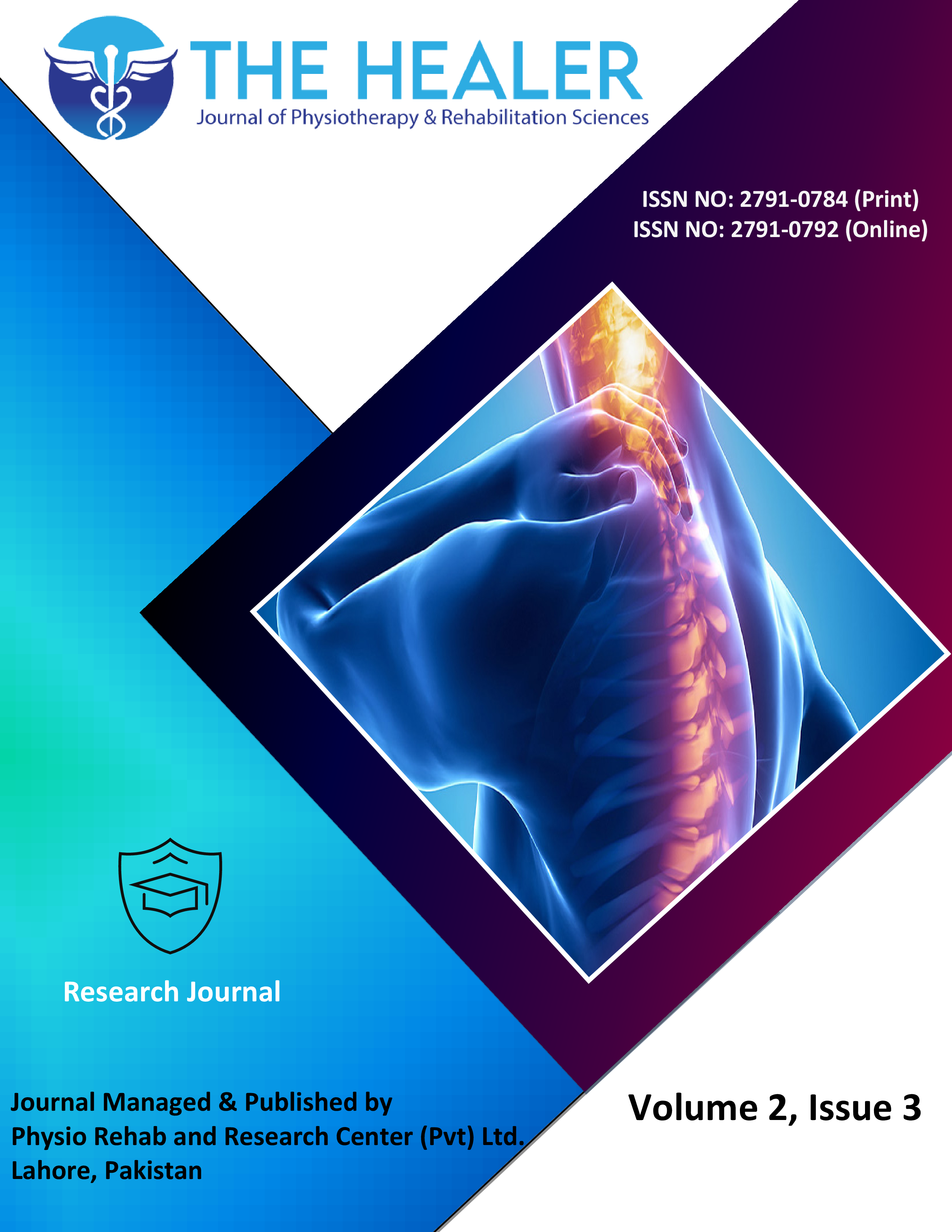Mechanism of Meniscal Injury and its Impact on Performance in Athletes
Meniscal Injury in Athletes
DOI:
https://doi.org/10.55735/hjprs.v2i3.98Keywords:
Athletic Performance, Meniscal Injury, Sports Injuries#Abstract
Background: In today’s life style, the gap between athletic activities and daily life activities is becoming wider. The daily life routine is becoming sedentary due to technology and sports activities and thus require high level of physical performance. Knee joint is the most vulnerable to rapid forces and injuries, in which meniscal injury is quite noticeable. Objective: To determine the mechanism of meniscal injury and its impact on performance in athletes after knee meniscal injury. Methods: After taking approval from ethical committee, consent was taken from the athletes prior to filling out the forms. The study was conducted on 145 male athletes in Lahore, aged between 17 to 40 years. Data was collected through international knee documentation committee subjective knee form which consisted of demographical data and questions which were divided into three sections; symptoms, sports activities and knee functions. Results: The main results regarding the mechanism of meniscal injury showed that there were 29% athletes having insidious tear, 16.6% acute noncontact, 32.4% contact with player and 22.1% non-specific mechanism of tear. The mean and standard deviation of total international knee documentation committee score was found to be 66.64±3.83, reflecting a moderately affected level of performance. Conclusion: The findings concluded that the common mechanism of meniscal injury was during contact with player or defense strategy during activity. The athletic performance level due to meniscal injury was moderately affected.
References
McEwen P, Balendra G, Doma KJTb, journal j. Medial and lateral gap laxity differential in computer-assisted kinematic total knee arthroplasty. 2019; 101(3): 331-9.
Kluczynski MA, Miranda L, Marzo JMJOJoSM. Prevalence and site of medial patellofemoral ligament injuries in patients with acute lateral patellar dislocations: A systematic review and meta-analysis. 2020; 8(12): 2325967120967338.
Magosch A, Mouton C, Nührenbörger C, Seil RJKS, Sports Traumatology, Arthroscopy. Medial meniscus ramp and lateral meniscus posterior root lesions are present in more than a third of primary and revision ACL reconstructions. 2021; 29(9): 3059-67.
Adams BG, Houston MN, Cameron KLJSm, review a. The epidemiology of meniscus injury. 2021; 29(3): e24-e33.
Gee SM, Tennent DJ, Cameron KL, Posner MAJCism. The burden of meniscus injury in young and physically active populations. 2020; 39(1): 13-27.
Patel H, Skalski MR, Patel DB, et al. Illustrative review of knee meniscal tear patterns, repair and replacement options, and imaging evaluation. 2021; 69: 4-16.
Makiev KG, Vasios IS, Georgoulas P, et al. Clinical significance and management of meniscal extrusion in different knee pathologies: a comprehensive review of the literature and treatment algorithm. 2022; 34(1): 1-11.
Gecelter RC, Ilyaguyeva Y, Thompson NEJTAR. The menisci are not shock absorbers: A biomechanical and comparative perspective. 2022; 305(5): 1051-64.
Gordon-Zigel M, Cothran VE. Meniscus injury. Common Pediatric Knee Injuries: Springer; 2021: 265-74.
Lu J, Chen Y, Hu M, Sun CJAoPM. Clinical efficacy of arthroscopy in the treatment of discoid meniscus injury and related risk factors for postoperative pain. 2020; 9(6): 4002-9.
Snoeker B, Turkiewicz A, Magnusson K, et al. Risk of knee osteoarthritis after different types of knee injuries in young adults: a population-based cohort study. 2020; 54(12): 725-30.
Filbay SR, Skou ST, Bullock GS, et al. Long-term quality of life, work limitation, physical activity, economic cost and disease burden following ACL and meniscal injury: a systematic review and meta-analysis for the OPTIKNEE consensus. 2022.
Poulsen E, Goncalves GH, Bricca A, Roos EM, Thorlund JB, Juhl CBJBjosm. Knee osteoarthritis risk is increased 4-6 fold after knee injury–a systematic review and meta-analysis. 2019; 53(23): 1454-63.
Kopf S, Beaufils P, Hirschmann MT, et al. Management of traumatic meniscus tears: the 2019 ESSKA meniscus consensus. 2020; 28(4): 1177-94.
Bhan KJC. Meniscal tears: current understanding, diagnosis, and management. 2020; 12(6).
Doral MN, Bilge O, Huri G, Turhan E, Verdonk RJEor. Modern treatment of meniscal tears. 2018; 3(5): 260-8.
Luvsannyam E, Jain MS, Leitao AR, Maikawa N, Leitao AEJC. Meniscus tear: pathology, incidence, and management. 2022; 14(5).
Petushek EJ, Sugimoto D, Stoolmiller M, Smith G, Myer GDJTAjosm. Evidence-based best-practice guidelines for preventing anterior cruciate ligament injuries in young female athletes: a systematic review and meta-analysis. 2019; 47(7): 1744-53.
Vaishya R, Kambhampati S, Vaish AJIjoo. Meniscal injuries in the olympic and elite athletes. 2020; 54(3): 281-93.
Li YJRBdMdE. Sports rehabilitation in athletes with meniscal lesions based on electroacupuncture associated with sports therapy. 2022; 29.
Lai CC, Ardern CL, Feller JA, Webster KEJBjosm. Eighty-three per cent of elite athletes return to preinjury sport after anterior cruciate ligament reconstruction: a systematic review with meta-analysis of return to sport rates, graft rupture rates and performance outcomes. 2018; 52(2): 128-38.
Ma J, Liu X, Lu H, et al. Effects of proprioceptive training in the recovery of patients submitted to meniscus surgery: systematic review and meta-analysis. 2022; 12(6): e055810.
Logan CA, Murphy CP, Sanchez A, et al. Medial collateral ligament injuries identified at the National Football League scouting combine: assessment of epidemiological characteristics, imaging findings, and initial career performance. 2018; 6(7): 2325967118787182.
Hernandez RJ, Lamplot JD, Hammond KE, et al. Knee injuries in the elite American football player: a descriptive pictorial imaging and mechanism of injury review. 2022; 46(2): 197-211.
Petrolo AJTJotCCA. Meniscal lesion or patellar tendinopathy? A case report of an adolescent soccer player with knee pain. 2022; 66(2): 157.
Presley J, Bailey L, Maloney K, et al. The influence of mode-of-injury on psychological readiness for return-to-sport following anterior cruciate ligament reconstruction: A matched-controlled study. 2021; 16(1): 177.

Downloads
Published
How to Cite
Issue
Section
License
Copyright (c) 2022 The Healer Journal of Physiotherapy and Rehabilitation Sciences

This work is licensed under a Creative Commons Attribution 4.0 International License.










